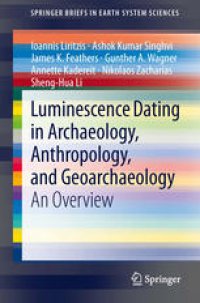
Ebook: Luminescence Dating in Archaeology, Anthropology, and Geoarchaeology: An Overview
- Tags: Earth System Sciences, Archaeology, Optics Optoelectronics Plasmonics and Optical Devices, Anthropology
- Series: SpringerBriefs in Earth System Sciences
- Year: 2013
- Publisher: Springer International Publishing
- Edition: 1
- Language: English
- pdf
The field of Luminescence Dating has reached a level of maturity. Both research and applications from all fields of archaeological science, from archaeological materials to anthropology and geoarchaeology, now routinely employ luminescence dating. The advent of optically stimulated luminescence (OSL) techniques and the potential for exploring a spectrum of grain aliquots enhanced the applicability, accuracy and the precision of luminescence dating. The present contribution reviews the physical basis, mechanisms and methodological aspects of luminescence dating; discusses advances in instrumentations and facilities, improvements in analytical procedures, and statistical treatment of data along with some examples of applications across continents, covering all periods (Middle Palaeolithic to Medieval) and both Old and New World archaeology. They also include interdisciplinary applications that contribute to palaeo-landscape reconstruction.
The field of Luminescence Dating has reached a level of maturity. Both research and applications from all fields of archaeological science, from archaeological materials to anthropology and geoarchaeology, now routinely employ luminescence dating. The advent of optically stimulated luminescence (OSL) techniques and the potential for exploring a spectrum of grain aliquots enhanced the applicability, accuracy and the precision of luminescence dating. The present contribution reviews the physical basis, mechanisms and methodological aspects of luminescence dating; discusses advances in instrumentations and facilities, improvements in analytical procedures, and statistical treatment of data along with some examples of applications across continents, covering all periods (Middle Palaeolithic to Medieval) and both Old and New World archaeology. They also include interdisciplinary applications that contribute to palaeo-landscape reconstruction.
The field of Luminescence Dating has reached a level of maturity. Both research and applications from all fields of archaeological science, from archaeological materials to anthropology and geoarchaeology, now routinely employ luminescence dating. The advent of optically stimulated luminescence (OSL) techniques and the potential for exploring a spectrum of grain aliquots enhanced the applicability, accuracy and the precision of luminescence dating. The present contribution reviews the physical basis, mechanisms and methodological aspects of luminescence dating; discusses advances in instrumentations and facilities, improvements in analytical procedures, and statistical treatment of data along with some examples of applications across continents, covering all periods (Middle Palaeolithic to Medieval) and both Old and New World archaeology. They also include interdisciplinary applications that contribute to palaeo-landscape reconstruction.
Content:
Front Matter....Pages i-vii
Introduction....Pages 1-4
Luminescence Dating Protocols and Dating Range....Pages 5-20
Dose Rate....Pages 21-24
Luminescence Dating of Archaeological Materials....Pages 25-40
Luminescence-Based Authenticity Testing....Pages 41-43
Luminescence Dating in Geomorphological and Geoarchaeological Research in Europe: Application Examples....Pages 45-59
Meteoritic Impacts, Tsunamis....Pages 61-63
Conclusions....Pages 65-66
Back Matter....Pages 67-70
The field of Luminescence Dating has reached a level of maturity. Both research and applications from all fields of archaeological science, from archaeological materials to anthropology and geoarchaeology, now routinely employ luminescence dating. The advent of optically stimulated luminescence (OSL) techniques and the potential for exploring a spectrum of grain aliquots enhanced the applicability, accuracy and the precision of luminescence dating. The present contribution reviews the physical basis, mechanisms and methodological aspects of luminescence dating; discusses advances in instrumentations and facilities, improvements in analytical procedures, and statistical treatment of data along with some examples of applications across continents, covering all periods (Middle Palaeolithic to Medieval) and both Old and New World archaeology. They also include interdisciplinary applications that contribute to palaeo-landscape reconstruction.
Content:
Front Matter....Pages i-vii
Introduction....Pages 1-4
Luminescence Dating Protocols and Dating Range....Pages 5-20
Dose Rate....Pages 21-24
Luminescence Dating of Archaeological Materials....Pages 25-40
Luminescence-Based Authenticity Testing....Pages 41-43
Luminescence Dating in Geomorphological and Geoarchaeological Research in Europe: Application Examples....Pages 45-59
Meteoritic Impacts, Tsunamis....Pages 61-63
Conclusions....Pages 65-66
Back Matter....Pages 67-70
....